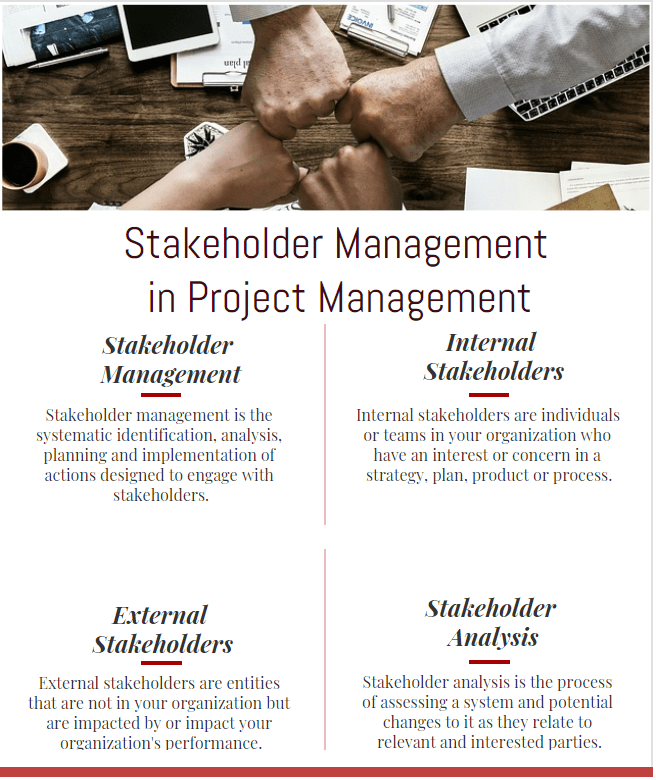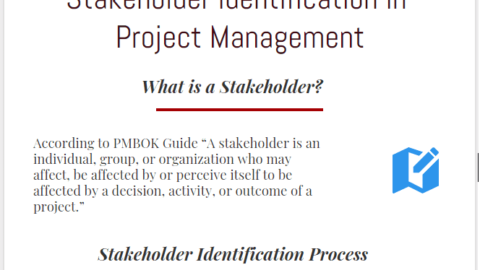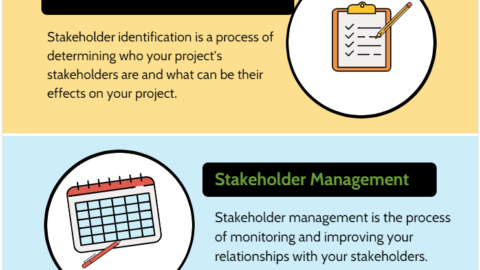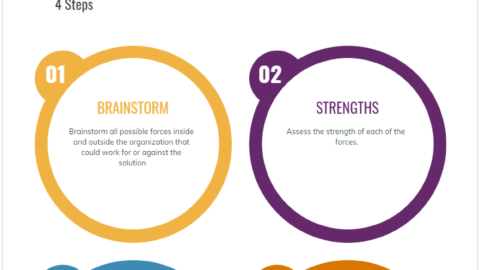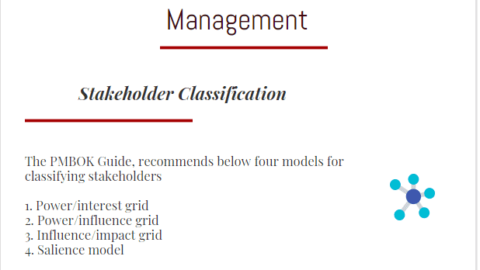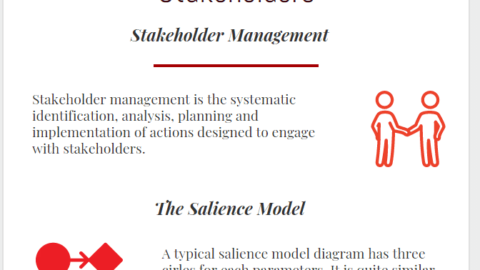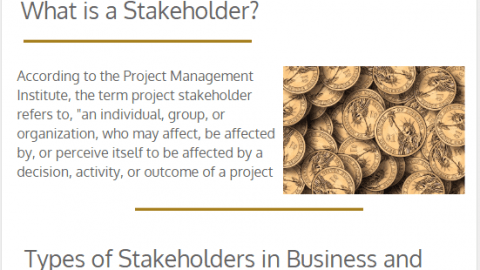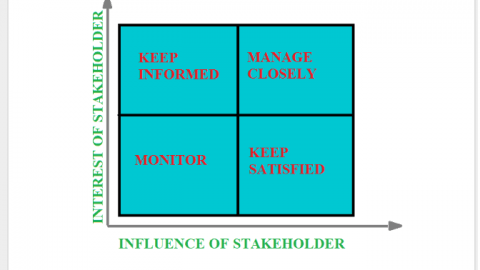Stakeholder Management in Project Management
Almost all projects are subject to external influences. Even if everything is clearly defined, all the deliverables are detailed, a project can never exist in isolation. Typically, projects are surrounded by people, organizations, internal and external shareholders who have a particular interest in the outcome of the project. When the stakeholders influence the project in order to meet their own requirements and expectations, this will create significant risks such as scope changes, an increase in complexity, costs, etc. However, if the stakeholder’s requirements are not addressed clearly or if they are not involved in the project, the project’s possibility of success will decrease. It is the project manager’s business to balance the stakeholder involvement and isolation in order to ensure project management successfully. In this article, we will discover who the internal and external stakeholders are in project management.
Table of Contents
Stakeholder Management
Stakeholders can be anyone or organization who has a stake or a particular interest in a project which is undertaken by an organization. They will be affected by the project’s outcomes and/or they will influence the project in some way. When they benefit from the project, they will be positive and supportive. Conversely, if the project has negative effects on their requirements, they might be negative and obstructive.
Therefore, maintaining good relationships which is a part of effective stakeholder management is a difficult and complex task because, a large number of people involved in a project with different levels of power, authority, and interests.
Internal and External Stakeholders
As discussed above, stakeholders can be anybody either internal or external to the organization. For example, regulatory bodies, neighbors, shareholders, funders are the stakeholders of a construction project. In order to perform successful stakeholder management, the project manager must classify and prioritize various needs and expectations. There may be numerous external stakeholders as well as internal ones within a project.
Typically stakeholders’ interest is high in the early stages of a project. Because they know that many things can be changed easily before the project starts. Once the project starts, changes become difficult and costly. Therefore communicating with them in the right way is critical for any type of project to share project risks.
Stakeholder influence tends to decrease when the project starts. However, it increases again just before the close-up phase.
Internal Stakeholders
Stakeholders can be classified into two major groups which are internal and external depending on their involvement in the project. The client organization may also involve stakeholders with different interests and expectation levels. A multiheaded client organization makes the decision-making process difficult.
Internal stakeholders are individuals or teams in your organization who have an interest or concern in a strategy, plan, product, or process. They can be anyone within the organization.
Examples of Internal Stakeholders
Below are some of the examples for Internal Stakeholders
- Auditors
- Board of Directors
- Executive Managers
- Operations Teams
- Internal Customers
- Portfolio Managers
- Program Managers
- Sponsors
- Business Units
- Users
External Stakeholders
External stakeholders are entities that are not in your organization but are impacted by or impact your organization’s performance. They may be individuals or organizations who are not part of the client organization. The number of external stakeholders may be high or low depending on the type of project. For example in a publicly funded project, the number of external stakeholders is often high. In private sector projects, stakeholder groups are often fewer than other projects.
Examples of External Stakeholders
Below are some of the examples for External Stakeholders
- Regulatory Authorities
- Subcontractors
- Suppliers
- Government
- Investors & Creditors
- Communities
- Organizations
- Partners
- Media and Press
How to Develop Your Stakeholder Management Strategy?
Whether your stakeholders have positive or negative impacts, you should manage them to get their support and mitigate their negative impacts to complete your project successfully. Because you need their experiences, investment and resources.
A positive stakeholder will benefit from the successful achievement of a project, such as an increase in the life quality or profit. Negative stakeholders will be impressed negatively by a successfully completed project so they will work to make the project slowed.
While developing your strategy to deal with them, you need to bear in mind the following;
- Your project’s size, complexity, resources, milestones, constraints, and duration.
- The level of support you need to reach the desired results. The support could include advice, funds, resources, sponsorship, etc.
- The available time to be spent on communication. You need to decide how to use your time effectively to receive stakeholder feedback. Using a power and interest grid for stakeholder mapping helps you to make time planning to deal with important stakeholders.
Stakeholder Analysis
Stakeholder analysis can be performed to understand the characteristics of the stakeholder environment in order to prioritize the resources of a project. Stakeholder identification is the first step to be done before making an analysis. At this step, you will make a list of all the people and organizations with the help of the project team. Then you decide each stakeholder’s power and interest in your project. A stakeholder analysis matrix can be a useful tool for this purpose.
Stakeholder Register
A Stakeholder register is a project management document that describes and classifies people, groups, and organizations involved in the project. It is a good practice to prepare this document at the beginning of projects.
Tips for Effective Stakeholder Management
Here below we gather up five tips to help you obtain and maintain stakeholder support for your project.
1. Create a Stakeholder Mapping Matrix
A matrix can help you to classify your project’s stakeholders according to their interests and influence. Develop your strategy according to the information gathered from the matrix. Thus, you will not waste time on stakeholders who have no interest and power. Don’t forget to keep the matrix updated throughout the life cycle of your project.
2. Understand What You Need From Each Stakeholder
Review your list of key stakeholders and think about what you need from each of them. Try to understand what role are you going to play in the success of your project. Will they provide you technical support, experience, or funds? If you need specific support, make sure you determine the right stakeholder for that. Note down the desired support from each of them.
3. Decide How to Engage Stakeholders With Your Project
You don’t need to do anything to engage some stakeholders with your project because they will have particular incomes. However, you need to persuade some stakeholders to provide their support. Try to formulate what they will receive from the project. Explain what benefits they are going to have.
4. Decide How to Communicate with Your Stakeholders
Communicating with each stakeholder in the right way will help you to get their support. For example, you should manage closely some stakeholders while you just keep some of them informed. Develop your strategies to focus on the most influential stakeholders first rather than dealing with less important ones. Spend the right amount of time to manage the right people.
5. Implement Your Plan for Stakeholder Management
After creating your plan for stakeholder management, begin to implement it. It is a good idea to divide your plan into smaller tasks and implement each phase. As the project progresses, stakeholder’s requirements and influence might change, so update your plan according to your project’s requirements.
Develop Your Stakeholder Management Strategy!
As we mentioned above, stakeholders can be anyone either external or internal to the organization. They may have various expectations and interests in the project. Stakeholder management is a significant task that must be carried out effectively from initiation to completion of a project. Management of internal stakeholders might be more difficult than external ones. Because internal stakeholders have more interest in the issues and they will be affected more than others.
Stakeholder management is key to any project’s success. It is important to ensure their participation and receive their comments at the early stages of a project. Because they will provide feedback and their experiences.
It is the project manager’s business to create good communication channels with the parties to ensure the project’s success. They need to involve the stakeholders in the process to share the risks, receive their support, and improve decision-making.
External Reference

Over 20 years in portfolio management, streamlining business processes, and systems integration. Utilizing best practices: PMI, Scrum, Agile, Kanban, Lean/Six Sigma, CMMI, ITIL and MOF. Extensive experience in managing in cross functional environment, getting to the root of the problem, bringing stakeholders together to resolve them. Vice President at Force3M Training.

